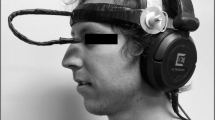Abstract
To study the impact of startle-induced arousal on attraction, blindfolded subjects in a “vestibular function” study were startled by a loud noise accompanying the sudden backward tilt of the dental chair in which they were seated. In Study I, startled male subjects indicated (on a “postexperimental” questionnaire) greater attraction toward a pretty female experimenter than did control subjects. Study II demonstrated the reverse, with startled male subjects disliking a male experimenter more than controls. In Study III, female subjects startled by a male experimenter indicated greater attraction than controls, although the pattern of their responses differed from males. While an attempt to induce misattribution of arousal to a (placebo) pill (Study IV) or to a noise (Study V) with “arousal” side effects resulted in negligible attenuation effects on the startle—attraction relationship, in Study VI the imposition of a delay period between startle and experimenter ratings resulted in reduced ratings of attraction. The role of arousal in romantic attraction is briefly discussed, and the relevance of these data to theories of emotion is considered.
Similar content being viewed by others
References
Berscheid, E., & Walster, E. H.Interpersonal attraction. Reading, Massachusetts: Addison-Wesley, 1969.
Cantor, J. R., Zillmann, D., & Bryant, J. Enhancement of experienced sexual arousal in response to erotic stimuli through misattribution of unrelated residual excitation.Journal of Personality and Social Psychology 1975,32 69–75.
Dienstbier, R. A. The role of anxiety and arousal attribution in cheating.Journal of Experimental Social Psychology 1972,8 168–179.
Dienstbier, R. A. Attribution, socialization, and moral decision making. In H. J. Harvey, W. Ickes, & R. F. Kidd (Eds.),New directions in attribution research (Vol. 2). Hillsdale, New Jersey: Lawrence Erlbaum Associates, 1978.
Dienstbier, R. A. Emotion attribution theory: Establishing roots and exploring future perspectives. In H. E. Howe & R. A. Dienstbier (Eds.),Nebraska symposium on motivation: Human emotion, 1978. Lincoln: University of Nebraska Press, 1979.
Dienstbier, R. A., Hillman, D., Lehnhoff, J., Hillman, J., & Valkenaar, M. C. An emotion-attribution approach to moral behavior: Interfacing cognitive and avoidance theories of moral development.Psychological Review 1975,82 299–315.
Dienstbier, R. A., & Munter, P. O. Cheating as a function of the labeling of natural arousal.Journal of Personality and Social Psychology 1971,17 208–213.
Dutton, D. G., & Aron, A. P. Some evidence for heightened sexual attraction under conditions of high anxiety.Journal of Personality and Social Psychology 1974,30 510–517.
Goldstein, D., Fink, D., & Mettee, D. R. Cognition of arousal and actual arousal as determinants of emotion.Journal of Personality and Social Psychology 1972,21 41–51.
Izard, C. E.Human Emotions. New York: Plenum Press, 1977.
Kenrick, D. T., & Cialdini, R. B. Romantic attraction: Misattribution versus reinforcement explanations.Journal of Personality and Social Psychology 1977,35 381–391.
Kenrick, D. T., & Johnson, G. A. Interpersonal attraction under negative conditions: A problem for the classical conditioning paradigm?Journal of Personality and Social Psychology, 1979, in press.
Mandler, G.Mind and emotion. New York: Wiley, 1975.
Marshall, G., & Zimbardo, P. G. The affective consequences of inadequately explained physiological arousal.Journal of Personality and Social Psychology, 1979, in press.
Maslach, C. Negative emotional biasing of unexplained arousal.Journal of Personality and Social Psychology, 1979, in press.
Nisbett, R. E., & Schachter, S. Cognitive manipulation of pain.Journal of Experimental Social Psychology 1966,2 227–236.
Patterson, M. L. An arousal model of interpersonal intimacy.Psychological Review 1976,83 235–245.
Ross, L., Rodin, J., & Zimbardo, P. G. Toward an attribution therapy: The reduction of fear through induced cognitive emotional misattribution.Journal of Personality and Social Psychology 1969,12 279–288.
Schachter, S., & Singer, J. E. Cognitive, social, and physiological determinants of emotional states.Psychological Review 1962,69 379–399.
Schwartz, G. E., Fair, P. L., Greenberg, P. S. Freedman, M., & Klerman, J. L. Facial electromyography in the assessment of emotion.Psychophysiology 1974,11 458.
Stern, R. M., Botto, R. W., & Herrick, C. D. Behavioral and physiological effects of false heart-rate feedback: A replication and extension.Psychophysiology 1972,9 21–29.
Valins, S. Cognitive effects of false heart-rate feedback.Journal of Personality and Social Psychology 1966,4 400–408.
Valins, S. Emotionality and information concerning internal reactions.Journal of Personality and Social Psychology 1967,6 458–463.
Walster, E. H., & Berscheid, E. Adrenaline makes the heart grow fonder.Psychology Today 1971,5 46–50; 62.
Watson, J. B., & Rayner, R. Conditioned emotional reactions.Journal of Experimental Psychology 1920,3 1–14.
Zillmann, D., Johnson, R. C., & Day, K. D. Attribution of apparent arousal and proficiency of recovery from sympathetic activation affecting excitation transfer to aggressive behavior.Journal of Experimental Social Psychology 1974,10 503–515.
Author information
Authors and Affiliations
Additional information
This research was supported by a grant from the Research Council of the University of Nebraska-Lincoln. The author wishes to thank Virginia Broady, Steve Slane, Nancy Kahn, Kathy Orr, and Cindy Smith, who acted as the researchers for Studies I, II and III, IV, V, and VI, respectively.
Rights and permissions
About this article
Cite this article
Dienstbier, R.A. Attraction increases and decreases as a function of emotion-attribution and appropriate social cues. Motiv Emot 3, 201–218 (1979). https://doi.org/10.1007/BF01650604
Issue Date:
DOI: https://doi.org/10.1007/BF01650604




